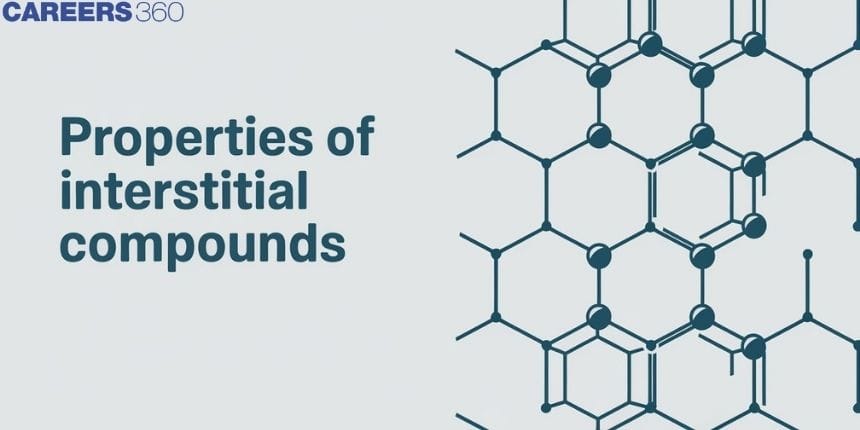Properties Of Interstitial Compounds - Chemistry
Transition metals are the elements that are found in the d-block of the periodic table (groups 3 to 12). They are called “transition” elements because they form a bridge (transition) between the highly reactive s-block elements and the less reactive p-block elements. Several interstitial compounds are formed by the transition metals. Have you wondered why steel (iron + carbon) is stronger than pure iron? How can a tiny atom fitting into the spaces between metal atoms change their properties so much? The answer lies in the properties of interstitial compounds
This Story also Contains
- Properties Of Interstitial Compounds
- Physical And Chemical Properties Of Interstitial Compounds
- Some Solved Examples
- Conclusion

There are various changes in the physical properties such as density, rigidity, hardness, malleability, ductility, electrical conductivity, etc. steel and cast iron are the interstitial compounds of iron which are formed with carbon. In the formation of these compounds, the malleability and ductility of iron are lost to a great extent, but the tenacity of the metal increases.
Properties Of Interstitial Compounds
Interstitial compounds are those that are formed when small atoms like H, C, or N are trapped inside the crystal lattices of metals. They are usually non-stoichiometric and are neither typically ionic nor covalent, for example, TiC, Mn4N, Fe3H, VH0.56 TiH1.7, etc. The formulas quoted do not, of course, correspond to any normal oxidation state of the metal. Because of the nature of their composition, these compounds are referred to as interstitial compounds. The principal physical and chemical characteristics of these compounds are as follows:
(i) They have high melting points, higher than those of pure metals.
(ii) They are very hard, some borides approach diamonds in hardness.
(iii) They retain metallic conductivity.
(iv) They are chemically inert.
Physical And Chemical Properties Of Interstitial Compounds
-
Hardness and Strength: Interstitial compounds are usually much harder and stronger than pure metals. Example: Steel (iron + carbon) is stronger than pure iron.
-
High Melting Points: They generally have very high melting points due to strong interactions between the metal lattice and small atoms (like C, N, H).
-
Metallic Conductivity: Despite the presence of non-metal atoms, these compounds often retain the metallic conductivity of the parent metal.
-
Chemical Inertness: Interstitial compounds are usually chemically inert and resistant to corrosion, making them durable.
-
Non-Stoichiometric Nature: They often do not have a fixed composition (e.g., TiC, Fe₃C) because small atoms can occupy varying amounts of interstitial sites.
-
Maintains Ductility: Even though they are harder, they often retain some ductility and toughness of the metal.
Recommended topic video on(Properties Of Interstitial Compounds)
Some Solved Examples
Q.1 The statement that is INCORRECT about the interstitial compound is:
(1) They are chemically reactive
(2) they are very hard
(3) they have metallic conductivity
(4) they have a high melting point
Solution:
As we learned -
The interstitial compound of transition metals
Compounds that are formed when small atoms like H, C, and N, etc are trapped inside the crystal lattices of metals called interstitial compounds
These compounds are very hard
These compounds are chemically inert
They have a high melting point, higher than that of the parent transition metals.
Incorrect option:- Interstitial compounds are very reactive.
Hence, the answer is the option (1).
.2 The major components of "Gun Metal" are
(1) Al, Cu, Mg and Mn
(2) Cu, Zn and Ni
(3) Cu, Ni and Fe
(4) Cu, Sn and Zn
Solution:
As we learned -
"Gunmetal" is an alloy of copper with tin and zinc.
Cu87%,Sn10%,Zn3%
It is used in machine parts, guns
Hence, the answer is the option (4).
Q.3 The incorrect statement among the following is :
1)RuO4 is an oxidizing agent
2)Cr2O3 is an amphoteric oxide
3) (correct)Red color of ruby is due to the presence of Co3+
4)VOSO4 is a reducing agent
Solution
The red color of Ruby is due to the presence of Cr3+ and not Co3+.
RuO4 is an oxidizing agent due to the +8 oxidation state of Ru.
Cr2O3 is an amphoteric oxide, CrO is a basic oxide, and CrO3 is an acidic oxide.
VOSO4 is a reducing agent.
The incorrect statement is given in Option (3).
Hence, the correct answer is option (3).
Practice More Questions With the Link Given Below
Conclusion
Interstitial compounds/alloys are substances that are formed when a small atom like carbon, hydrogen, boron, or nitrogen can occupy space in their lattice. The conductivity exhibited by them is similar to their parent metal. These compounds are very hard. The hardness of some borides is comparable to that of a diamond. These compounds are chemically inert. Their densities are less than the parent metal.